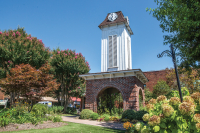Resurrecting Balsam Mountain Preserve is one part business, two parts passion
New owners of the high-end Balsam Mountain Preserve development aren’t daunted by the choppy waters of Western North Carolina’s real estate landscape.
Despite the still tepid demand for pricey second homes in the mountains, they say they have charted a course that will bring the beleaguered development out on the other side of the storm still raging across the rest of the region.
The 4,400-acre mega-development — one of the region’s few mountainside golf developments that can rightfully carry that tag line — has its share of battle scars. It’s been through foreclosure, repossessed by investors, hawked to the lowest bidder, babysat by an out-of-state caretaker, then put up for sale.
Now, a rescue of Balsam Mountain Preserve has come full circle. Two wealthy homeowners in the development teamed up to buy the development for $6 million — a fraction of what it was once worth.
If there’s ever a development where millionaire homeowners could emerge from the ranks to become the owners, it’s Balsam Mountain Preserve. Harry Avant of Louisiana and David Carlile of Texas knew each other previously from the oil and gas industry, even before buying their respective property in Balsam Mountain Preserve several years ago.
They have hired two former members of the Balsam sales team to come back and run the place. Jimmy McDonnell and Bruce Fine both worked together at Balsam Mountain Preserve under the original owners and developers.
Related Items
“We know the owners, we know the property, we know the employees, we know the project, we know the market,” Fine said of their return, this time as president and vice president.
The hunt for solid ground in today’s new real estate landscape is more than just a financial deal for the new team.
“If there wasn’t a significant upside from a financial and business perspective we probably wouldn’t have done it. These guys are not a nonprofit entity,” Fine said. “But to save a place that you really have an emotional connection to, and it could be a good business decision at the same time, is a win-win overall.”
For the past 18 months, Balsam Mountain Preserve has been in limbo. The former owners defaulted on $19 million in debt and went into in foreclosure. The development landed in the hands of a private equity firm that immediately began looking to unload it.
So what, exactly, did Avant and Carlile get for their $6 million purchase of Balsam Mountain Preserve?
For starters, they own a really, really nice Arnold Palmer golf course. All the amenities, from the swimming pool to tennis courts to clubhouse to riding stables, are also included.
But as for what’s marketable — the pieces of the development that are worth something — there are about 130 to 150 home sites left to sell off.
Only one lot has sold in Balsam Mountain Preserve this year, however.
“2011 was kind of a lost year for Balsam. It was for sale and people knew it was for sale,” Fine said.
Despite the unimpressive showing, the new team isn’t fretting over whether Balsam Mountain Preserve will make it. Optimism over the new owners is already fueling sales, Fine said. There are two contracts pending — one on a new lot and one on an existing lot being resold by a property owner.
“We have more activity in the week we have owned this place than we’d had all year,” Fine said early last month. “People are moving forward now because it is stable. They like the story about the homeowners who have joined together and bought the place.”
Few golf course developments can claim to have that bumpy road behind them.
“Every other one has the loom of foreclosure and takeover,” McDonnell said.
Fine said few are going to emerge as intact as Balsam.
“There are so many communities in the mountains that have nothing there other than a front entrance and some renderings on paper. Those are the places that have fallen off the end of the earth,” Fine said.
At Balsam Mountain Preserve, there is enough “critical mass” already in play, Fine said. The golf course is finished, the swimming pool has water, a restaurant and clubhouse are functioning. Roads actually lead to the lots — a novelty compared to some subdivisions that lack even that bare essential.
Most importantly, though, are the 70 homes on the ground and another 110 property owners of lots. Too many subdivisions in the mountains are empty ghost towns, and just like no one wants to eat in an empty restaurant, no one wants to be the first to build — not when it’s such a buyer’s market. And that’s why homes on the ground are an important part of Balsam’s critical mass.
Nowhere to go but up
As the rest of the nation plunged into a recession in 2008, WNC seemed insulated from the real estate crash — its quality of life, desirable views and retirement reputation helped it hang on.
But by the end of that year, the economy finally caught up with the region — and with Balsam Mountain Preserve. Lot sales simply evaporated.
With no cash coming in, the former developers Chaffin and Light, a highly reputable company known for massive eco-developments from South Carolina’s coast to Colorado, defaulted on its $19 million loan.
Chaffin had bargained hard for a work out, hoping to get an extension or refinance on the outstanding debt. Meanwhile, property owners at Balsam made a bid to save their own development from foreclosure. They raised $8 million and explored forming their own LLC to bail out Balsam Mountain Preserve and own the development themselves.
But the private equity firm, TriLyn, was unwilling to negotiate for anything less than a full payoff of the $19 million owed.
Marc Antoncic, the managing partner of the firm, arguably was in a tough spot. He was supposed to be earning investors a return on their money — not losing their money. So he had a choice. Cut his losses, take what he could get and get out — even if it meant selling Balsam at a rather substantial loss.
His other choice was to step in to the developer’s shoes himself, hoping to turn it around.
“You can’t rescue everything, but you can’t just sit back and hope it goes away,” Antoncic said in an interview 18 months ago, shortly after his take over. “If you bail today, you lose all that. We would turn over a good asset to someone else.”
In hindsight, it now seems he made the wrong choice.
He didn’t turn it around, and only got $6 million for the development in the end.
“Literally every deal they had on the table, whether it was Jim Chaffin or the homeowners, everyone of those was better than what they ultimately got,” Fine said.
“They had some great opportunities in front of them they chose not to take,” McDonnell agreed.
Homeowners, for their part, are optimistic for the first time since 2009 when Balsam Mountains Preserve headed down the path to foreclosure.
“Ever since then Balsam has been in a real state of uncertainty,” Fine said.
What would happen to the golf course had been one of their biggest fears. Well-groomed fairways with that perfect phosphorescent green hue come at a steep price. The golf course had been losing $1 million a year. The original developers, Chaffin and Light, were underwriting the cost of the golf course operations. Picking up that price tag is part of what sunk the developers.
After foreclosure, homeowners had to pony up the money to operate the course.
A new model
There are only a handful of developments in WNC in the same league as Balsam Mountain Preserve: of a similar acreage, prestige, price range and quality. And they too are seeing a comeback, suggesting the market has at long last bottomed out, Fine said.
“Prices are lower compared to where they were at in 2006, but they are coming back,” Fine said. “It sounds cliché-ish, but for someone who wants to be here this is when people want to strike. We aren’t at the bottom anymore.”
That financial strategy is part of Fine’s sales pitch. But the other part is far more emotional.
“The person who is waiting for the bottom is putting off living their life,” Fine said.
Indeed, the pent-up demand is why Fine has such a rosy outlook for 2012.
“The dynamic is people have put their plans on hold for anywhere from three to four years,” Fine said. “I’ve been sitting on the sidelines, I’m not any younger, I’m not any healthier, my grandkids are getting older.”
And that reality could drastically change the real estate paradigm in WNC. Before, baby boomers looked for lots to build their dream home on. But building a house — from deciding on a layout for the master walk-in closet to choosing the color of granite for the kitchen counter — can take two to three years. These days, prospective buyers want to get on with it — and perhaps spare their marriage the strain of a custom-built house — even if it means they won’t be picking out their own light fixtures or tile floor design.
“People want something they can move into,” Fine said. “In conjunction with that dynamic, people are also no longer buying what they can afford, they are buying less than they can afford in a lot of cases.”
People used to buy at the upper end of their limit — assuming that real estate would always be worth more next year anyway. But with appreciation less of a sure bet these days, second-home buyers are rethinking.
“Seriously, do I need 6,000 square feet in retirement? That’s how affluent people are thinking today,” Fine said.
Which means Balsam Mountain Preserve must retool its model — as with the rest of WNC’s developers.
“It is not going to be all about 2-acre single family home sites,” Fine said. “If you sit around and wait for individual home site buyers to come visit you one at a time, it will be years and years and years before you sell through all your availability.”
What’s in Balsam Mountain Preserve’s cards now would have been borderline blasphemy several years ago: smaller lots, pre-built homes, and even perhaps townhomes.
“Balsam has never had that, ever,” Fine said.
There are about 35 lots in the current phase of the development already platted and ready to sell. Another 100 or so are in the works, and will like take the form of smaller, more closely spaced lots rather than larger, spread-out ones. And, they could be sold with homes already on them rather than empty lots.
As a development, Balsam Mountain Preserve doesn’t particularly want to get into the spec home business. Developers generally sell lots, builders build homes.
But that’s where Balsam Mountain Preserve once again hopes to tap its unique base of homeowners.
Homeowners, eager to see their own community succeed, may actually finance construction of model homes by a builder. The homeowner would theoretically be helping out the builder they used and liked when building their own home, make a little money and help land new neighbors to keep Balsam Mountain Preserve stable.
“The developers who can facilitate these alliances between people who can finance — i.e., non-banks — and the builders, those are the communities that are really going to thrive in this segment,” Fine said.









